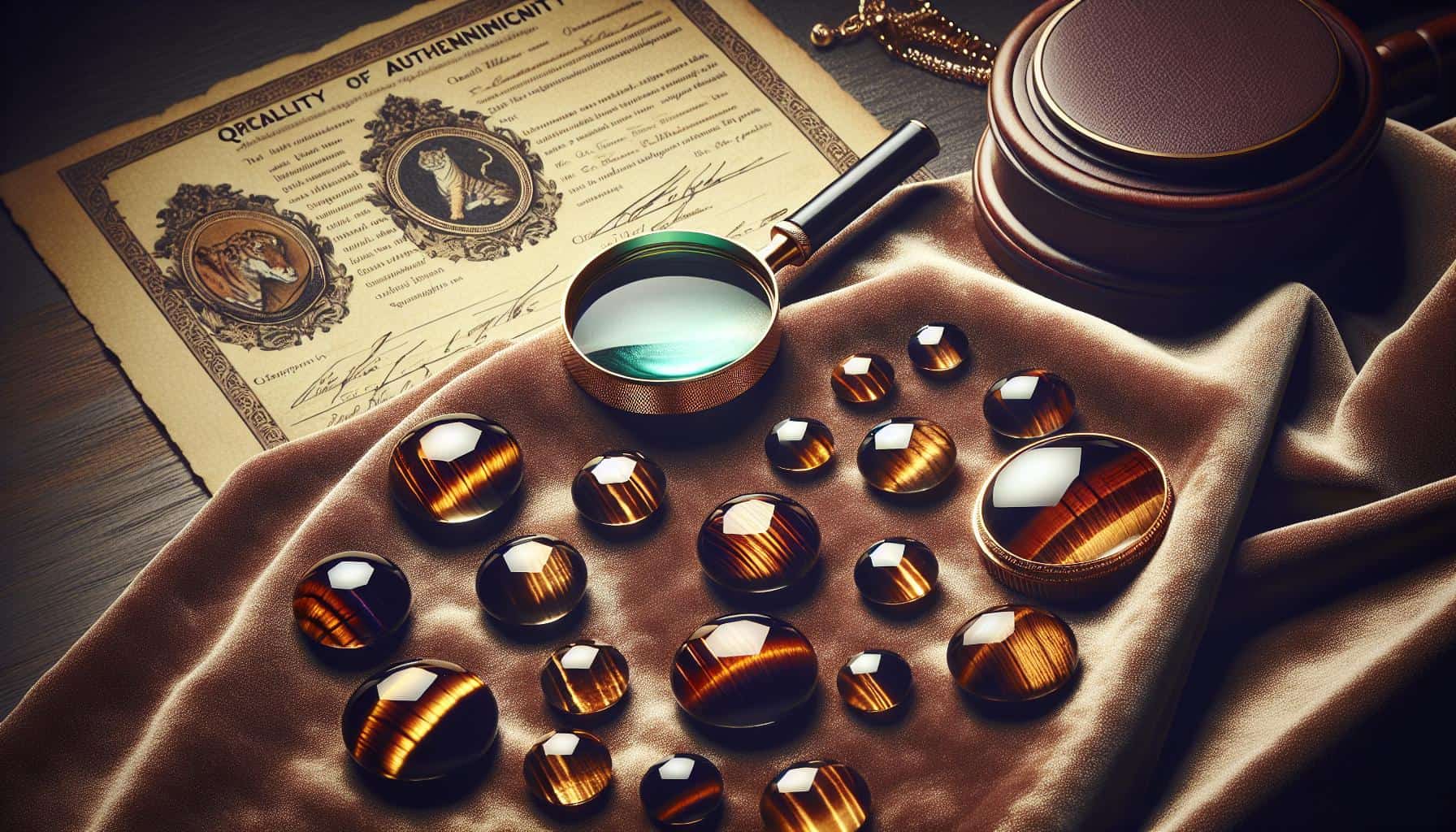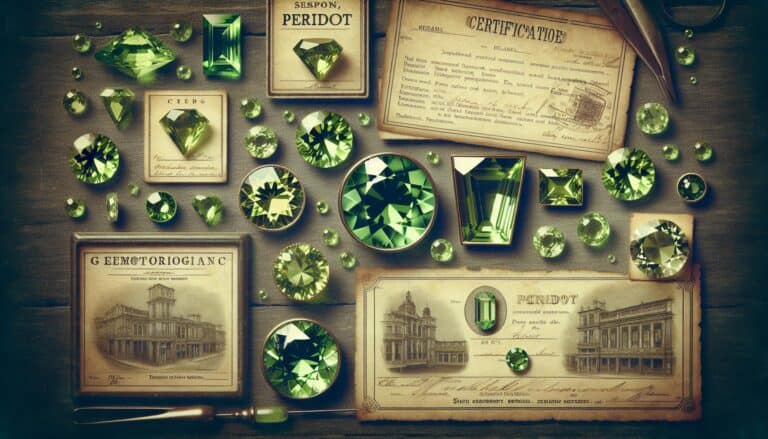Ever wondered what gives the tiger’s eye gemstone its alluring appeal?
It’s not just its silky luster that turns heads, but also its unique affordability. Whether you’re a seasoned collector or a curious newbie, understanding the value of tiger’s eye is key.
You’re in for a surprise when you dive into the world of tiger’s eye pricing. Factors like color, clarity, and cut play a huge role in determining its worth.
Stay tuned as we unravel the mysteries behind the value of this captivating gemstone.
Tiger’s eye value is influenced by color, clarity, cut, and rarity. Its unique chatoyancy and hues from golden yellow to deep red-brown are key. Availability is generally high, affecting its affordability. When buying, ensure authenticity through certification, and consider quality over size for better investment.
What Is Tigers Eye?
Tiger’s eye is a chatoyant gemstone that boasts an incredible silky luster, akin to the keen gaze of a jungle cat. This distinct sheen is thanks to its fibrous structure, with asbestos fibers being replaced by silica over time, leading to the formation of this precious stone. Found in hues of golden yellow to deep red, tiger’s eye captures the essence of earthy tones that resonate with many jewelry enthusiasts.
Originating from rugged landscapes, predominantly in South Africa, tiger’s eye has also been unearthed in parts of Australia, India, and the USA. You’ll appreciate its versatility, as artisan craftsmen shape it into beads, cabochons, and intricate carvings. Not only is the stone used in various types of personal adornments, but it’s also a popular pick for home decor items, such as bookends and statues, celebrating its natural beauty.
Beyond its visual appeal, tiger’s eye purportedly holds metaphysical properties. It’s said to grant the wearer courage, protection, and confidence, and is often sought after by those looking to tap into a deeper spiritual connection with the world around them. Whether for its spiritual allure or its captivating appearance, tiger’s eye maintains its position as a beloved stone in the realms of fashion and holistic practices.
Given its widespread availability and the public’s enduring fascination with its appearance and lore, tiger’s eye continues to hold a place of honor in the hearts of collectors and fashion-forward individuals alike. Remember that while its beauty is evident, the true value of tiger’s eye is often determined by personal sentiment and the quality of the piece at hand.
Tigers Eye Prices: Factors That Affect Value

Over the years, tiger’s eye gemstones have captivated many with their unique beauty, but when it comes to evaluating their worth, several factors play a pivotal role. Understanding these factors will help you gauge why prices can vary so dramatically and what to look out for if you’re planning to purchase or sell tiger’s eye.
Color, Clarity, and Cut Quality
Your tiger’s eye’s value hinges significantly on its Color, Clarity, and Cut Quality. When evaluating color, look for a stone that exhibits a vivid, well-defined contrast between the golden and brown hues, which is a hallmark of high-quality tiger’s eye. The intensity and saturation of color can boost a gemstone’s appeal and, consequently, its value.
In terms of clarity, tiger’s eye is generally opaque, but the more seamless and sharper the cat’s eye effect, or chatoyance, the more valuable the stone tends to be. Stones without any visible defects or cracks are preferred, and those with a smooth, undisturbed wave of light can command higher prices.
The cut of a tiger’s eye is crucial to showcasing its best features. An expert cutting can enhance the stone’s chatoyance and overall appearance. A well-proportioned and skillfully crafted cabochon—or rounded dome cut—which is commonly used for tiger’s eye, often fetches a premium price.
Market Demand and Availability
Another significant factor affecting the price is the Market Demand and Availability. Tiger’s eye is relatively abundant, which usually leads to a lower price point compared to rare gemstones. Yet, certain unique pieces or those of particularly fine quality can still be highly sought after and, therefore, more expensive.
Keep an eye on market trends as well. The gemstone’s popularity can fluctuate, influenced by fashion trends and cultural interest. Pieces of jewelry or objets d’art that incorporate tiger’s eye in trendy or bespoke designs might see an upsurge in value.
While the market is generally well-supplied with standard material, the supply of exceptional tiger’s eye can be quite limited. As with all gemstones, rarity is a key factor: the rarer the stone, the higher the potential price. Collectors and enthusiasts are often willing to pay more for unique specimens, such as those with an unusual color blend or particularly striking chatoyance.
Understanding Tigers Eye: A Rare Gem

The Rarity of Tigers Eye
When you’re exploring the value of tiger’s eye, it’s essential to understand the gem’s rarity. Unlike diamonds or rubies, tiger’s eye is a pseudomorph of quartz. This means it begins as another mineral, blue asbestos, and over time, the silica in quartz replaces it while maintaining the original fibrous shape. This transformation process is rare and contributes to the tiger’s eye value. Found primarily in South Africa and Western Australia, the best quality stones are riveting with their uncanny depth and illusion of movement, known as chatoyancy.
The colors of tiger’s eye range from golden yellow to deep red-brown. The gemstone’s value often peaks with stones displaying the most vibrant, saturated colors. The presence of iron oxide influences the color patterns and plays a significant role in enhancing the gemstone’s overall appeal and rarity.
Origins and Characteristics
Tiger’s eye gemstones intrigue collectors and enthusiasts alike, not only for their captivating appearance but also for their origins and unique properties. Tracing its roots, tiger’s eye can be primarily linked to regions with ancient volcanic activity. Your piece of tiger’s eye likely began its formation millions of years ago deep within the earth.
The distinguishing features of tiger’s eye are its silky luster and the remarkable ‘cat’s eye’ effect or chatoyancy it exhibits when cut and polished. This effect is caused by the reflection of light off the parallel intergrowths of quartz crystals and altered amphibole fibers that have become limonite. When evaluating tiger’s eye:
- Look for smoothness and symmetry in cut and polish.
- Note the sharpness of the cat’s eye line.
- Observe the quality of the color and depth of the gemstone.
The combination of these characteristics, along with its captivating origins, make tiger’s eye a desirable addition to any gemstone collection. Its earthly tones connect you to nature while the hypnotic appearance of the stone brings a unique aesthetic element to jewelry pieces.
Tigers Eye Grading and Valuation
The Grading System for Tigers Eye
When you decide to purchase a tiger’s eye gemstone, understanding its grading system can greatly aid in discerning its quality and worth. Tiger’s eye gemstones are not graded in the same meticulous manner as diamonds; however, key aspects are considered to assess their quality. These aspects include color intensity, chatoyancy strength, surface smoothness, and weight.
Color Intensity is paramount, and stones with deep, rich hues typically command higher prices. The desired shades range from golden yellow to deep red-brown, with each color variation reflecting a different kind of tiger’s eye. The more even and saturated the color, the better.
Chatoyancy, or the ‘cat’s eye’ effect, makes tiger’s eye truly unique. A well-defined silky band that shifts with the light will increase the gem’s attraction, thus adding to its value. Sharpness and clarity are highly prized in chatoyancy.
Surface Smoothness is another significant factor. A polished stone with a smooth surface, free of pits or blemishes, showcases the inherent beauty of tiger’s eye and is considered of higher quality.
Finally, the stone’s Weight, typically measured in carats, directly impacts its value. Larger stones with desirable qualities are relatively rare, making them more valuable.
To assist you in the grading process, seek a reliable gemologist or dealer familiar with gemstone quality factors specific to tiger’s eye.
Certification and Appraisal
To attest to the authenticity and quality of tiger’s eye, certification and appraisal are essential tools. A Certification from a reputed gemological laboratory offers an unbiased assessment of the stone’s characteristics and confirms its identity. The certificate will include details such as type, size, cut, color quality, and any treatments the stone may have undergone.
When it comes to Appraisal, having your tiger’s eye gemstone professionally appraised provides you with its current market value. This is especially important for insurance purposes or if you’re considering selling the gemstone. An appraisal typically considers the same factors as the grading, but also takes into account current market trends and demand.
Remember, while a certification can confirm the authenticity of your tiger’s eye, it’s the appraisal that will enlighten you on its monetary worth. For investment pieces or significant purchases, always opt for stones that have both certification and professional appraisal.
It’s worth noting that not all tiger’s eye gemstones come with certificates, particularly lower value items. However, if you’re investing in a high-quality piece or one of significant size, documentation can add to the assurance and potentially to the resale value.
Current Market Trends in Tigers Eye Pricing
When you’re on the hunt for tiger’s eye, it’s critical to stay abreast of current market trends which significantly impact pricing. Like any gemstone, tiger’s eye fluctuates in price based on a variety of market conditions. Recently, an increased interest in holistic and wellness-related products has driven the popularity of tiger’s eye, positioning it favorably among gemstone enthusiasts.
In terms of color preferences, the classic golden to red-brown hues remain steadfast favorites. However, blue tiger’s eye, also known as hawk’s eye, has seen a surge in demand due to its unique color and perceived rarity. This shift has contributed to an uptick in prices for specimens that showcase quality color and chatoyancy.
Another influential factor is the source of the gemstone. With main deposits in South Africa and Thailand, any changes in mining regulations or export restrictions can directly impact availability and, consequently, pricing. In recent times, ethical sourcing has also become a key consideration for buyers. Stones with verifiable ethical origins tend to fetch a higher price, as more consumers are willing to invest in sustainable and responsibly sourced gemstones.
Advancements in technology have also played a role in the tiger’s eye market. Enhanced cutting and polishing techniques result in a better showcase of the stone’s natural beauty which has helped cultivate a broader audience for the gemstone, inadvertently pushing the prices higher for well-crafted pieces.
Tracking the historical pricing data suggests that tiger’s eye retains a fairly consistent value, with peaks often corresponding with general economic prosperity and increased interest in personal accessories.
| Year | Average Price per Carat (USD) |
|---|---|
| 2020 | 6 |
| 2021 | 7 |
| 2022 | 8 |
Remember, while high-grade tiger’s eye with exceptional characteristics can command premium prices, even standard grades hold steady in value, making purchasing any quality of this gemstone a potentially sound investment.
The Most Expensive Tigers Eye
When you’re on the hunt for high-quality tigers eye, you’ll find that the most expensive pieces are typically a cut above the rest, boasting impeccable features that set them apart from the standard. Exceptional color saturation paired with a silky luster and eye-visible chatoyancy are hallmarks of a premium gemstone. In this exclusive market segment, it’s the unique attributes that command top dollar.
Let’s delve into what makes these specimens the crown jewels of the tigers eye family. The value of the most sought-after tigers eye can exceed that of their more common counterparts by a significant margin. For example, pieces that display sharp and vivid chatoyant bands that seem to glide across the stone as it moves in light are particularly prized among collectors and enthusiasts alike.
| Attribute | Low-Grade Value | High-Grade Value |
|---|---|---|
| Color Intensity | Moderate | Vibrant |
| Chatoyancy Quality | Visible | Striking |
| Size | Small | Large |
A true rarity in the market is the blue tigers eye, also known as hawk’s eye. This variant, due to its less common occurrence, can often carry a heftier price tag. Ethical sourcing and traceable origins are additional factors that can elevate the worth of tigers eye. Jewelry and ornamental pieces with documented provenance or featuring artisan craftsmanship attract a premium in today’s market.
While determining the top end of tigers eye values, it’s important to remember that these stones don’t often hit the open market and are usually traded within private networks. Hence, prices may not be as transparent as other gemstones. Rarity and desirability drive the value, and the most expensive tigers eye pieces are those that balance all the desirable qualities with finesse. They’re not merely stones; they’re natural masterpieces that have been sculpted by earth and enhanced by the skillful hands of craftspeople.
Buying Tigers Eye: Tips and Recommendations
When you’re in the market for this captivating gemstone, knowing where and how to purchase high-quality tiger’s eye is crucial. Follow these tips and recommendations for a satisfying acquisition.
Where to Purchase High-Quality Tigers Eye
For quality assurance:
- Visit Reputable Dealers: Seek out established jewelers and specialty stores known for their quality gemstones. Experience and good customer feedback are indicators of a trustworthy source.
- Attend Gem Shows: These events give you the opportunity to see a wide range of tiger’s eye stones and speak directly with the vendors about the origin and quality of their pieces.
- Online Marketplaces: When shopping online, read product descriptions carefully and check the seller’s ratings. Reliable online retailers will provide detailed information and credible certification for their gemstones.
When selecting a piece:
- Look for stones with intense colors and strong chatoyancy.
- Prefer gemstones with no visible scratches or blemishes to ensure a higher grade.
- Consider the cut and see if it enhances the stone’s natural beauty.
Ensuring Authenticity and Value
To guarantee you’re getting an authentic tiger’s eye and realizing its true value, there are specific steps you should take:
- Ask for Certification: Reputable sellers can offer a certificate of authenticity that confirms the stone’s natural origins and absence of treatments.
- Understand the Pricing: Research current market trends for tiger’s eye and compare prices among different sellers to avoid overpaying.
- Professional Appraisal: If you’re looking at a particularly expensive piece, consider having it appraised by an independent gemologist to verify its worth.
In your due diligence:
- Examine the stone under different lighting conditions to check its luster and clarity.
- Inquire about the return policy to ensure you can return the stone if it doesn’t meet your expectations after purchase.
- Educate yourself about the variations within tiger’s eye, taking note that each type might carry a different price point due to rarity and demand.
Armed with these tips, you’re better equipped to navigate the world of tiger’s eye, identifying pieces that are not just beautiful but also valuable. Whether you’re adding to your personal collection or investing in gemstones, understanding the nuances of tiger’s eye will help you make more informed purchasing decisions.
Conclusion: Buying & Selling Tigers Eye
Understanding the value of tiger’s eye is about more than just its price tag.
It’s about appreciating the qualities that make each stone unique. Whether you’re drawn to its rich colors, intrigued by its clarity, or seeking the perfect cut, you’ll find that the true worth of this gemstone lies in its ability to meet your specific desires and needs. Remember to purchase from reputable sources, ask for certification, and consider a professional appraisal to ensure you’re getting the best value for your investment.
With these strategies, you’re ready to make a confident choice that reflects both your personal style and your understanding of tiger’s eye’s worth.







